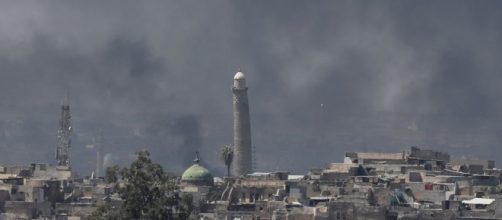According to Lise Grande, the U.N. deputy special representative and humanitarian coordinator in Iraq, ISIS is keeping up to 150,000 civilians trapped in the Old City located in western Mosul. It’s believed that ISIS is preventing these civilians from leaving so that they can be used as human shields, and are also shooting anyone attempting to flee. There have already been more than 7,000 gunshot wounds treated, injuries sustained by people leaving ISIS-controlled districts.
The conditions in the Old City are considered dire, with very little food and water for the remaining civilians still trapped there.
Since the Battle of Mosul began back in October of last year, 860,000 people have fled the city, which is beyond the worst case scenario originally projected by the U.N. However, thanks to arrangements made with Iraq’s military, the potential refugee crisis this could cause has been somewhat averted.
#News #Headlines WND U.N. believes up to 150,000 civilians trapped in Mosul https://t.co/SpjIIHfpQy
— Parker Daily (@GetParkerDaily) June 17, 2017
The Battle of Mosul
Since 2014, ISIS has maintained control of Mosul, the second largest city in Iraq, in addition to large portions of both northern and western Iraq. With the implementation of their strict system of law inspired by Wahhabism, along with the numerous war crimes they have committed, the international community could not allow this to persist.
On October 16, 2016, a U.S.-led coalition consisting primarily of Iraqi government forces launched a joint offensive to take back the city from ISIS which was deemed Operation “We Are Coming, Nineveh.” Since then, the joint coalition has managed to retake eastern Mosul -- with ISIS still maintaining control of the western side of the city. However, fighting for western Mosul has proven to be slow and difficult, with ISIS’ implementation of human shields and other defensive measures.
ISIS’ main stronghold in western Mosul is in the Old City, which is where the largest concentration of the remaining civilians is located. With ISIS essentially treating these people as prisoners, the U.N. is expecting military action to take back the Old City relatively soon.
Humanitarian issues
When the Battle of Mosul began, the U.N. initially projected that up to 750,000 civilians would flee the city to avoid getting caught up in the crossfire. As mentioned earlier, 860,000 people have escaped Mosul since the start of the operation, which posed as a problem for the U.N., along with the rest of the humanitarian community. While the situation has stabilized since then, there’s no telling how long it’ll last.
Grande has made it clear that if more than 40,000 people flee at once, it would be far beyond the U.N.’s capabilities (with their current resources) to help them. Because of this, the Iraqi military have taken extra precautions to make sure that less than 20,000 people flee per day.
As of now, U.N. safety zones have been averaging 8,000-15,000 refugees per day.
With the current situation in Mosul’s Old City, the influx of refugees from the area could prove to be overwhelming for the U.N. With their current refugee camps already operating at near maximum capacity, the liberation of the Old City could become a serious humanitarian issue.


